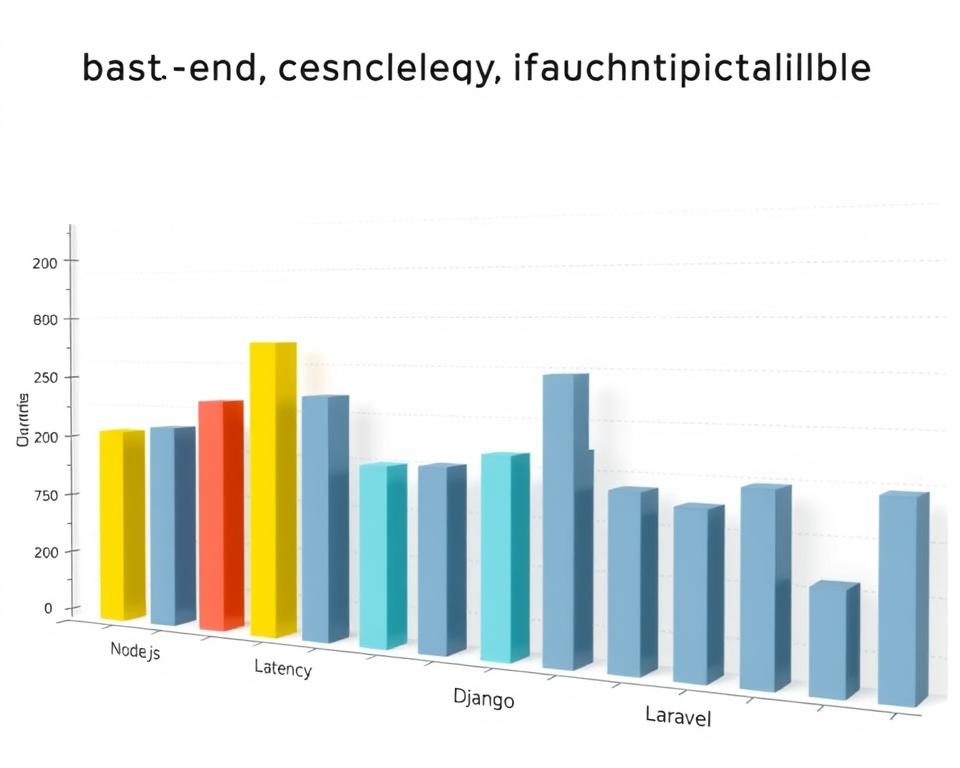Back-end development is key in making web apps work. It focuses on the server side to make apps dynamic and interactive. With Node.js, Django, and Laravel leading, the need for skilled back-end developers is growing. This article will dive into back-end tech, covering its good and bad sides. We’ll also help you pick the best tech for your project.
As web apps get more complex, back-end development is more important. It’s about server-side coding, making apps strong and able to grow. Node.js, Django, and Laravel are among the top choices, each with unique features and tools for web app development.
Table of Contents
Introduction to Back-End Technologies
Back-end development is a big part of making web apps work. It’s all about server-side coding for dynamic and interactive apps. Node.js, Django, and Laravel are at the top, offering tools and features for web app development.
Key Takeaways
- Back-end development is a critical component of web application development
- Top back-end technologies include Node.js, Django, and Laravel
- Server-side programming is a key aspect of back-end development
- Back-end development involves creating robust and scalable web applications
- Top back-end technologies offer a range of features and tools to support web application development
Understanding Back-End Development Fundamentals
Back-end development is key for making web apps strong and growable. It uses server-side processing to talk to databases and share data with users. Back-end techs handle the app’s logic, database work, and API links.
Knowing the basics of database management is vital. This means designing and setting up databases well. With these skills, developers make apps that are quick, safe, and can grow.
- Server-side processing and logic
- Database design and implementation
- API connectivity and integration
- Security and authentication
By focusing on these areas, developers can make web apps that are great for users and meet their needs.
Next, we’ll look at Node.js in back-end development. We’ll see how it helps make web apps scalable and efficient.
Node.js: The JavaScript Runtime Revolutionary
Node.js is a JavaScript runtime built on Chrome’s V8 JavaScript engine. It offers an event-driven, non-blocking I/O model. This makes Node.js lightweight and efficient, perfect for real-time web apps. It’s also a top pick for server-side programming thanks to its huge package and module ecosystem.
Some key features of Node.js include:
- Event-driven, non-blocking I/O model
- Lightweight and efficient
- Real-time web application support
- Vast ecosystem of packages and modules
Node.js is great for server-side programming and can handle lots of traffic. It’s ideal for big applications. Its support for microservices architecture also makes it a favorite for modern web development.
Django: Python-Powered Web Framework
Django is a top-notch Python web framework for building strong and growing web apps. It’s designed to make development easier with its MVT (Model-View-Template) architecture. This setup keeps things organized and makes updates simpler.
Django also comes with built-in security tools like authentication and authorization. These help protect against web attacks, keeping your app safe. It also supports scalability, like load balancing and caching, for handling big traffic and data. To learn more about comparing popular backend technologies, visit comparing popular backend technologies.
Some of the key features of Django include:
- Modular design, allowing for easy reuse of code
- Extensive libraries and APIs for common tasks, such as database integration and file uploads
- Support for both relational and non-relational databases
Django is a strong and adaptable Python web framework for complex web apps. Its MVT architecture and security features make it a top pick for developers. It’s perfect for building secure and scalable apps.
Using Django lets developers create top-notch apps that meet user needs. It’s great for both small and big projects. Django has a big community and lots of documentation, making it a top choice for Python web development.
Laravel: PHP Framework Excellence
Laravel is a top PHP framework for web app building. It has a clean syntax and modular design, making it simple for newbies. It offers tools like routing, middleware, and caching for scalable apps.
Laravel shines in web application development with its database migration support. This helps developers manage database changes smoothly. It also supports API development, perfect for building RESTful APIs.
Some key features of Laravel include:
- Routing and middleware
- Caching and queueing
- Database migrations and seeding
- API development and authentication
Laravel is a strong and adaptable PHP framework for complex web apps. Its simplicity, rich features, and big developer community make it ideal for any web project.
Performance Comparison of Leading Back-End Technologies
Choosing the right back-end technology is key. Performance comparison is a big deal. The speed and how fast a technology responds are very important. We’ll look at Node.js, Django, and Laravel in this section.
Each technology has its own strengths and weaknesses. Node.js is fast and light, perfect for real-time apps. Django and Laravel have more features, but they might be slower.
- Speed and response time: How fast a technology can handle requests and respond to users.
- Resource consumption: How much memory, CPU, and other resources it needs to run.
- Scalability: Its ability to handle more traffic and users.
By looking at these factors, developers can choose the best technology for their project. This ensures the best performance and user experience.
Security Features and Considerations
Security is key in back-end development. Developers focus on making web apps safe and strong. Authentication and authorization are crucial. They make sure only the right people can see and change data.
Security tools like data encryption and safe coding are vital. Encryption keeps sensitive data safe from hackers. Safe coding stops common web problems. These steps help keep web apps safe from cyber attacks and protect user data.
Important security thoughts for back-end work include:
- Strong authentication and authorization systems
- Secure data sending with HTTPS
- Checking and cleaning user input to block attacks
- Keeping software up to date to avoid bugs
By focusing on security, developers make web apps that keep user data safe.
Database Integration Capabilities
Database integration is key in back-end development. It connects a web app to a database, allowing data exchange. Good database integration ensures smooth data flow, cuts down errors, and boosts app performance. SQL database support is vital, as it lets developers work with relational databases using SQL.
NoSQL integration is also important, especially for big amounts of unstructured data. NoSQL databases are flexible and scalable, perfect for fast web apps. Developers use Object-Relational Mapping (ORM) tools to make database integration easier.
- Database compatibility: Ensuring the chosen database management system is compatible with the application’s programming language and framework.
- Scalability: Selecting a database that can handle increasing amounts of data and user traffic.
- Security: Implementing robust security measures to protect sensitive data and prevent unauthorized access.
Understanding database integration’s importance helps developers create strong, scalable, and secure web apps. Good database integration, including SQL and NoSQL support, is crucial for success.
Development Speed and Learning Curve
In back-end development, development speed and learning curve matter a lot. The tech you choose can really affect how fast you can work on a project. Big names like Node.js, Django, and Laravel have different speeds and learning levels.
Node.js is fast and easy to learn. Its JavaScript setup lets developers quickly make and launch apps. Django, though, is harder to learn because of its complex design. But it’s great for making big, safe apps.
Here are some important points about back-end techs’ speeds and learning levels:
- Node.js: Fast development speed, low learning curve
- Django: Slower development speed, higher learning curve
- Laravel: Moderate development speed, moderate learning curve
The right tech choice depends on your project’s needs and your team’s skills. Thinking about speed and learning helps developers pick the best tech for success.
Community Support and Ecosystem Analysis
Choosing a back-end technology means looking at community support and ecosystem. A strong community offers resources like documentation, tutorials, and forums. We’ll explore the community support and ecosystem of top back-end technologies. We’ll focus on package availability, documentation quality, and community size and activity.
Package Availability and Documentation Quality
Package availability is key in a technology’s ecosystem. For example, Node.js has a huge package library through npm, making it easy to find and install dependencies. Django also has a wide range of libraries and tools for common tasks. Good documentation is also important, as it affects learning and development experience.
Community Size and Activity
A big and active community is crucial for a technology’s success. It offers support, helps with new features, and solves issues. Node.js, for instance, has a large and active community with many conferences, meetups, and forums. Smaller communities might not offer the same level of support.
| Technology | Community Size | Activity Level |
|---|---|---|
| Node.js | Large | High |
| Django | Medium | Medium |
| Laravel | Small | Low |
In conclusion, community support and ecosystem analysis are vital when picking a back-end technology. By looking at package availability, documentation quality, and community size and activity, developers can make smart choices. This ensures the success of their projects in the long run.
Deployment and Hosting Considerations
When it comes to back-end development, deployment and hosting are key. Developers need to pick the right options to make sure their web apps work well. Cloud hosting is a favorite because it’s flexible and saves money.
Serverless deployment lets developers write code without managing servers. This can cut costs and make apps more scalable. Big names like Amazon Web Services, Microsoft Azure, and Google Cloud Platform offer cloud hosting.
Choosing the right deployment and hosting is important. Developers should think about scalability, security, and cost. They should weigh the good and bad of cloud hosting and serverless deployment. This way, they can make sure their apps are reliable and meet user needs.
There are more options like containerization and hybrid deployment too. Developers should look into these to find what works best for them.
Real-World Application Scenarios
In back-end development, real-world application scenarios are key to success. From enterprise solutions to startup apps, the right tech makes a big difference. We’ll look at how back-end development applies to real-world uses.
E-commerce sites, social media, and online banking are common examples. These need strong back-end systems to manage lots of data and users. Enterprise solutions like Node.js, Django, and Laravel are top picks for their scalability and security.
Back-end development is also vital for startup applications. Startups need flexible back-ends that can grow fast. Python, Ruby on Rails, and PHP are favorites for their ease and quick development. Key points for startup applications include:
- Scalability and flexibility
- Security and data protection
- Integration with third-party services
By knowing the different real-world application scenarios and picking the right tech, developers can build apps that are scalable, secure, and easy to maintain. These apps meet the needs of their users.
Future Trends in Back-End Development
The world of back-end development is always changing. New technologies and trends pop up every year. One big future trend is serverless computing. It lets developers create and run apps without worrying about servers. This makes things cheaper and more flexible.
Another important trend is using artificial intelligence and machine learning. These tools can automate tasks, make things run smoother, and keep data safe. For instance, AI can spot and stop cyber threats. Machine learning can also make database queries better and apps faster.
To keep up with future trends in back-end development, developers need to stay informed. They can do this by going to conferences, joining online forums, and following industry leaders. This way, they can create cutting-edge apps that meet today’s user needs. For more on the latest back-end development trends, check out nextbigtechnology and see how to stay current.
Adopting serverless computing and other future trends in back-end development brings many benefits. These include:
- Lower costs and more flexibility
- Better performance and security
- More efficient and productive developers
By embracing these trends and technologies, developers can make innovative apps. These apps meet today’s user needs and keep developers competitive.
Conclusion
The back-end development world has changed a lot. Now, developers have many strong tools and frameworks to make web apps that grow and work well. Node.js, Django, and Laravel are just a few examples that meet different needs and likes.
Looking ahead, web app development will keep getting better. New trends and tech will make back-end developers even more powerful. By keeping up with these updates, experts can keep their skills sharp and their apps leading in innovation.



















